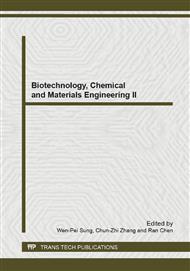p.951
p.955
p.959
p.962
p.967
p.971
p.975
p.979
p.984
Kinetics of Inhibition Effect of 4-hydroxy-3-methoxybenzoic acid on Mushroom Tyrosinase
Abstract:
A study on the kinetics of inhibitory effect of 4-hydroxy-3-methoxybenzoic acid on the monophenol- and diphenol-oxidation activity of mushroom tyrosinase has been carried out using enzymological kinetic analysis method in a Na2HPO4-NaH2PO4 buffer solution (pH=6.8) at 30 °C. The results show that 4-hydroxy-3-methoxybenzoic acid efficiently can inhibit both monophenol- and diphenol-oxidation activity of mushroom tyrosinase under experiment conditions. Concentrations of 4-hydroxy-3-methoxybenzoic acid leading to 50 % inhibition rate (IC50) on monophenol- and diphenol-oxidation activity were calculated to be 1.3 mmol/L and 2.6 mmol/L respectively, which are lower than that of arbutin (IC50 = 5.3 mmol/L for diphenol-oxidation activity). The presence of 4-hydroxy-3-methoxybenzoic acid also prolongs the lag period in oxidation of L-tyrosine via tyrosinase — A 4.7-minute lagging was observed in the presence of 4 mmol/L 4-hydroxy-3- methoxybenzoic acid, compared to a 1.1-minute lagging in the absence of inhibitor. The inhibition kinetics analyzed by Lineweaver-Burk plots found 4-hydroxy-3- methoxybenzoic acid to be a mixed-type inhibitor for the oxidation of L-DOPA, the equilibrium constants for inhibitor binding with free enzyme, KI , and with enzyme-substract complex, KIS, were 1.76 mmol/L and 8.57mmol/L respectively.
Info:
Periodical:
Pages:
967-970
Citation:
Online since:
January 2013
Authors:
Price:
Сopyright:
© 2013 Trans Tech Publications Ltd. All Rights Reserved
Share:
Citation:


